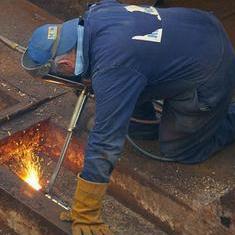 根據西班牙科學家最新的研究指出,工作場所的化學污染源會跟噪音產生交互作用加劇因工傷造成的聽力障礙。在歐洲,因噪音而造成的聽力損失是最常見的職業病,並且在年輕族群中有愈來愈常見的趨勢。
根據西班牙科學家最新的研究指出,工作場所的化學污染源會跟噪音產生交互作用加劇因工傷造成的聽力障礙。在歐洲,因噪音而造成的聽力損失是最常見的職業病,並且在年輕族群中有愈來愈常見的趨勢。
研究團隊在那瓦拉醫療系統期刊(Anales del Sistema Sanitario de Navarra)中發表的研究論文裡,分析了多種心理層面與化學污染物間的交互作用,以及這些作用在558名金屬業勞工身上所造成的衝擊。
這份新研究的主筆,同時也是薩拉戈薩大學的研究學者康提(Juan Carlos Conte)指出,「與工作環境中只有相同強度的噪音的勞工相較,工作環境中同時有噪音與焊接煙霧的勞工雖然較晚才出現聽力改變。但是他們的聽力改變則更為嚴重。」
康提解釋,「我們偵測到跟銲接煙霧有關的問題就是,勞工保護設備足以減低噪音的強度,但是卻不足以降低化學污染的效應。」
纖維面罩或其他類似的面罩沒有效果,因為這些面罩只具有過濾如煤炭粒子的功能,但是對像一氧化碳這樣有毒的氣體分子卻沒有過濾的功效。
研究學者發現,有噪音的工作場所若同時使用金屬加工液體,勞工通常會配戴面罩來保護呼吸器官,但同樣的情形勞工卻不常配戴聽力保護器具防止噪音傷害。
研究學者指出其他與工作相關的聽力損失因素,例如抽菸被認為是造成初期聽覺創傷的因素之一,而在工作環境外的噪音則會造成更進一步的聽力傷害。
歐盟的勞工安全衛生署(European Agency for Safety and Health at Work)在2006年指出,因噪音造成的聽力損失是歐洲最常見的職業傷害。並且建議暴露在高度噪音以及化學物質下的勞工應該更注意在數種風險因子的加成效應。
在美國,暴露於化學物質與聽力損失的關係才剛剛開始釐清。疾管局(Centers for Disease Control and Prevention)聽力損失研究計畫(Hearing Loss Research Program)的科學家公布了40份在1989年到2005年間完成的與化學物質與噪音交互作用相關內容的手稿。
美國國家職業安全與衛生機構(National Institute for Occupational Safety and Health, NIOSH)指出,不僅有些工業、建築、農業常用的化學物質對聽力有危害,當工作場所同時有化學污染物質跟噪音出現時,人們對於化學物質對聽力造成的職業安全危害仍然非常低。NIOSH估計約有1千萬名的美國勞工暴露這樣的工作場下。
直到2007年,對噪音與化學物質暴露關係的了解才越來越多,NIOSH表示「我們已經了解到許多不同的因素可能會造成或是增加職業聽力損失,像是噪音、藥物、老化、基因、耳毒性化學物質。而其他的化合物,像是抗氧化物,似乎對噪音所引起的損害有保護的功效。」而藥理科學研究院則建議在檢查聽力危害的監測作業中加入同時暴露於噪音與化學物質的項目。
NIOSH的目標是在2016年以前,針對噪音暴露以及職業聽力損失對三大優先工業進行追蹤,分別是礦業、建築業,以及造船業。
Chemical contaminants in a work environment can interact with noise and modify the way in which work-related deafness manifests, according to new research conducted by Spanish scientists. Noise-related hearing loss is the most common occupational disease in Europe and is increasingly common among young people.
"Workers exposed to noise in the presence of metalworking fluids exhibit a delay in hearing alteration in comparison with those exposed only to noise at the same intensity," said Juan Carlos Conte, lead author of the new study and a researcher at the University of Zaragoza.
"However," he said, "those exposed to noise in the presence of welding fumes experience increased hearing alteration."
In the study, published in the journal "Anales del Sistema Sanitario de Navarra," the team analyzed the way in which various physical and chemical contaminants interact, and the impact this had on hearing alteration in 558 metal workers.
"A problem we detected with respect to welding fumes in the presence of noise was that the protection used is effective for reducing the intensity of noise, but not for reducing the effects of the chemical contaminant," Conte explained.
Cellulose masks or others made of similar compounds had little effect in this case, since their capacity to filter particles such as charcoal had no effect on toxic gas molecules such as carbon monoxide.
In noisy atmospheres with metalworking fluids, people have the advantage of being able to use masks as respiratory protection, the researchers found, although the ear protection must be used in the same way to ensure that a worker is comprehensively protected from noise.
The researchers point to other factors in work-related hearing loss. Tobacco was found to contribute to initial acoustic trauma, while exposure to noise outside the work environment impacts on advanced acoustic injury.
The European Agency for Safety and Health at Work recognized in 2006 that noise-related hearing loss is the most common professional disease seen in Europe, and suggests greater focus should be placed on combined risk factors in workers exposed to the combination of high noise levels and chemical compounds.
In the United States, the relationship between chemical exposure and hearing loss is beginning to be better understood. Scientists with the Hearing Loss Research Program of the Centers for Disease Control and Prevention published 40 manuscripts on chemical-noise interactions between 1989 and 2005.
The National Institute for Occupational Safety and Health, NIOSH, says while there are chemicals commonly found in industry, construction, and agriculture that are hazardous to hearing alone, or when combined with noise, there is very little awareness in the occupational health community of the chemical hazards to hearing.
NIOSH estimates that almost 10 million American workers are exposed to occupational combinations of noise and chemicals that pose a hazard to their hearing.
By 2007, understanding of the relationship between noise and chemical exposure had grown. NIOSH responded to a review of its Hearing Loss Research Program by the National Academy of Sciences Institute of Medicine by saying in part, "It is recognized now that many different factors can cause or potentiate occupational hearing loss: noise, pharmaceuticals, aging, genes and ototoxic [ear damaging] chemicals. Other compounds, such as antioxidants, appear to have a protective effect against damage from noise."
In its review, the Institute of Medicine recommended that such exposures be included in a surveillance initiative that examines hearing hazards.
In response, NIOSH established a goal that by 2016 it would track noise exposure and occupational hearing loss in three high priority industrial sectors - mining, construction, and shipyard manufacturing.
全文及圖片詳見:ENS報導

